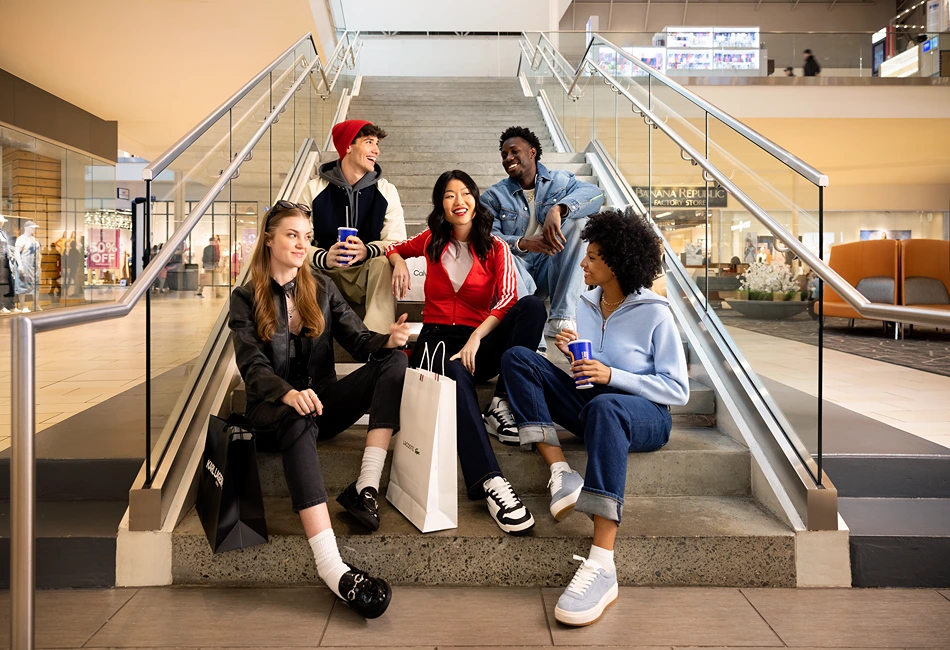Sites related to the NFL’s Green Bay Packers top the list of visitor attractions. Other diversions include riverboat cruising and a classic car museum.
By Randy Mink, Senior Editor
Because season tickets for Green Bay Packers football games have been sold out since 1960 and the waiting list exceeds 150,000, chances are slim that casual visitors to Wisconsin’s oldest and third-largest city will ever get to see a game there.
In many other ways, however, they can tap into team lore and gauge locals’ passion for their hometown’s storied NFL franchise.
As the smallest American city hosting a big-time professional sports team, Green Bay—with 107,000 residents and a metro population of 326,000—is inextricably identified with the Packers. Rather than being the property of a partnership, corporate entity or billionaire individual, the Packers—unique as a business model—are fan-owned. A publicly traded, nonprofit corporation since 1923, Green Bay’s pride and joy has 539,000 shareholders in all 50 states, plus Guam, Puerto Rico, the U.S. Virgin Islands and Canada.
Green Bay and Its Packers
Unlike in places such as New York and Chicago, the team plays a larger-than-normal role in city life. Traditions are strong, the fan-player connections tight.
Packers players are often seen around town, in stores and restaurants. In summer, local kids lend players their bikes to ride from the locker room to the practice field during training camp. In winter, town folk pitch in to shovel snow from the stands and get paid for it.
The financial impact on game weekends, moreover, is enormous, resulting in a $15 million infusion for the local economy. In a bigger urban market, such a cash flow would be “just a blip on the radar,” says Nick Meisner, vice president of marketing & communications for Discover Green Bay. “For us, it’s everything.”
While football heritage is Green Bay’s chief claim to fame and selling point tourism-wise, the northeast Wisconsin city brims with other itinerary possibilities, surprising outsiders with its diversity of cultural attractions, broad range of restaurants and watering holes, and quality of life.
U.S. News & World Report named Green Bay No. 1 in its latest rankings of Best Places to Live in the U.S. Another recent coup: The city has been chosen to host the NFL Draft in 2025.
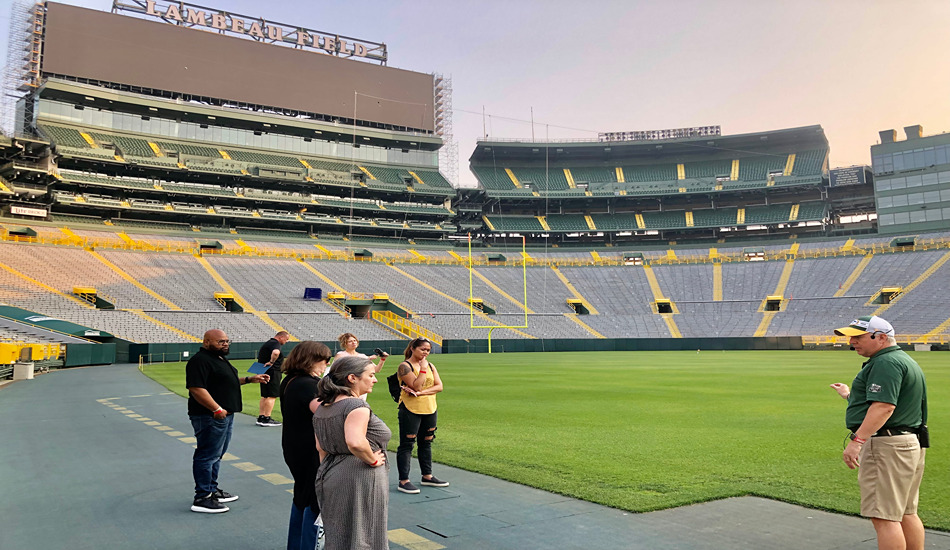
Lambeau Field Tour. (Randy Mink Photo)
Lambeau Field: A Shrine to Football’s Green Bay Packers
Many first-time visitors make a beeline to fabled Lambeau Field, the country’s third-oldest major-league sports stadium in continuous use. Only Chicago’s Wrigley Field (1914) and Boston’s Fenway Park (1912) have been around longer than Lambeau, built in 1957.
Year-round, behind-the-scenes tours let guests pass through the players’ tunnel (to a recording of cheering fans) and onto the track that circles the turf, a blend of natural grass and stitched-in synthetic fibers that promotes a safer playing surface and eliminates the chance of playing in mud. Known for hosting some of the coldest games ever played, Lambeau Field, nicknamed the Frozen Tundra, and Green Bay often are mockingly viewed as occupying some frigid wasteland up in North Country. One of the NFL’s largest venues, Lambeau has a capacity of 80,735 spectators.
The stadium, in a residential neighborhood on the southwest side of Green Bay, in 2003 underwent a $295 million modernization, adding a six-story atrium. On the main floor of the cavernous space are entrances to 1919 Kitchen & Tap, open year-round for lunch and dinner, and Green Bay Packers Hall of Fame. At the restaurant’s bar, gleaming copper pipes lead to 80 taps dispensing nearly 40 varieties of beer.
What to See in Green Bay Packers Hall of Fame
Hall of Fame exhibits chronicle one of the greatest stories in sports. Visitors hear players describing historic games in their own words and scroll through touch screens to click on audio segments and game video clips. They view game-worn jerseys, helmets and shoes of all-time heroes like quarterbacks Bart Starr, Brett Favre and Aaron Rodgers.
Visitors also learn about legendary figures like Curly Lambeau, who founded the Packers in 1919 and served as head coach for the franchise’s first 31 seasons, and Vince Lombardi, the coach who led the Packers to five NFL championships in the 1960s, helping turn a small Midwestern city into a sports paradise. (Lambeau, who played for the team as well as coached, had worked at a meatpacking plant, thus the name Packers.) Artifacts on display include Lombardi’s coaching shoes and jacket, plus commercial products like a Lombardi board game and lunchbox. A replica of his office is one of the most popular exhibits.
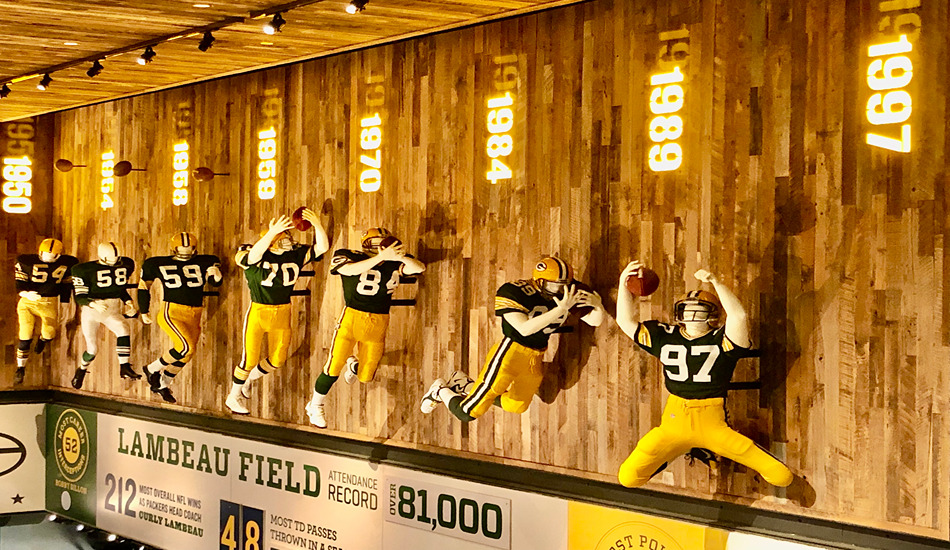
Packers Hall of Fame (Randy Mink Photo)
The Championship Gallery showcases the Packers’ “crown jewels,” an impressive collection of NFL Championship trophies and items such as Rodgers’ 2010 Super Bowl XLV ring. (The Packers won the first two Super Bowls in 1966 and 1967. Starting with the 1970 Super Bowl, the award was named the Vince Lombardi Trophy). The team claims a record 13 NFL championships, the last one in 2010. No trophy was given for the first three titles (1929-1931).
In a darkened hall leading to the trophy room, the walls bear mounted bronze footballs, each engraved with the name of a Hall of Fame inductee.
Shown on vintage televisions in one mini-theater are clips of crucial games, plus commercials that feature players like “Golden Boy” Paul Hornung, who pitches an electric shaver in a 1960s black-and-white ad.
The Ice Bowl Theater shows footage of the memorable December 31, 1967, NFL Championship game played in -13̊ weather. It was so cold, you learn, that halftime entertainment was cancelled when 11 members of the University of Wisconsin-Lacrosse marching band had to be hospitalized for frostbite after the morning practice session. TV announcer Frank Gifford said it all: “I think I’ll take another bite of my coffee.” In dramatic fashion, the Packers beat the Dallas Cowboys with 13 seconds left when Bart Starr scored the winning touchdown on a quarterback sneak.
Shopping and Photo Ops at Lambeau Field and Environs
The spacious Packers Pro Shop, connected to the atrium by an escalator, sells every kind of green-and-gold logo gear/wear imaginable, from jerseys and helmets to slippers and tote bags. You find banners and blankets, bobbleheads and bottle openers, beach towels and baby rattles. In the plaza outside the shop, on the side of the stadium facing Lombardi Avenue, are statues of Lambeau and Lombardi.
The best selfie op, though, is a bronze sculpture of four cheering fans standing behind a green padded wall, a festive ensemble honoring a home-game tradition—the Lambeau Leap—in which the touchdown scorer jumps into the end-zone stands to celebrate with the crowd. The Leap was initiated December 21, 1993, by former Packers safety LeRoy Butler in a match against the Los Angeles Raiders on a 0̊ day.
Across the street, residents’ backyards also demonstrate team spirit, with messages on the fences and player statues painted green and gold.
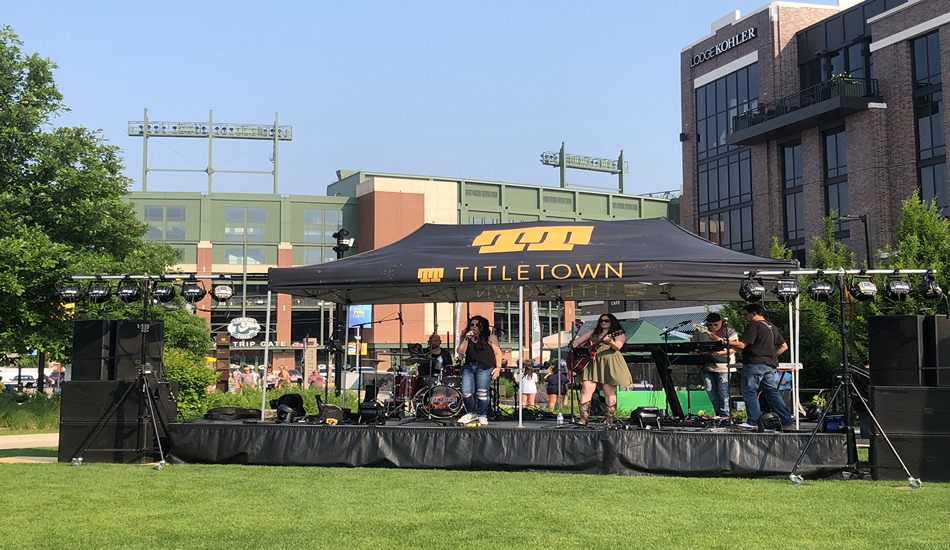
Titletown is an entertainment/residential district across the street from Lambeau Field. (Randy Mink Photo)
Next door to Lambeau Field, Titletown is a new residential community and gathering place for special events. Among its offerings:
- A full-size football field open for public play
- Ping pong tables and a bocce ball court
- Tubing and ice skating in winter
- A brewpub operated by Hinterland, the largest player in Green Bay’s thriving craft beer scene
- A summertime Thursday evening market with musical entertainment
Green Bay adopted the nickname “Titletown U.S.A.” as it prepared to host its first NFL championship game in 1961, when the Packers won the first of five titles under Lombardi. Titletown signs and banners were displayed throughout downtown as the city flaunted its civic pride.
Following the Packers Heritage Trail in Green Bay, WI
For a look at Packers history in downtown Green Bay and beyond, visitors can follow the Packers Heritage Trail, which is marked by 25 bronze commemorative plaques (14 downtown) with gold letters on a dark green background. They can do a self-guided walking or driving tour or sign up for a narrated, 90-minute trolley tour offered on select dates by the stadium’s tour department.
In the best photo op along the trail, multiple bronze sculptures dominate a Washington Street plaza that enshrines the city’s affection for the Green and Gold. A few blocks away, a plaque outside St. Willebrord Catholic Church describes how Lombardi faithfully attended weekday morning Mass during his 10 years in Green Bay, entering through the side door minutes before the 8 a.m. service. Visiting-team players worshipped there before heading to the stadium. The historical marker at the old Chicago & Northwestern Depot, now a restaurant, tells how fans used to turn out to greet the team as it boarded the train or arrived home; outside the 1899 station, with its landmark clock tower, stands a giant Packers player statue atop a boulder-sized football.
Green Bay’s Historic Hotel Preserves City and Team Traditions
From shortly after it opened in 1924 through the 1960s, Hotel Northland, a downtown gem on the Packers Heritage Trail, was Green Bay’s social center for anything related to the Packers. Nearly every visiting team stayed at the Northland into the 1970s, and some Packers players lived there, as did Lambeau and Lombardi for brief periods. After years of decline as senior/low-income housing and then abandonment, the hotel reopened in 2019 under the Marriott Autograph Collection banner and today glistens anew.
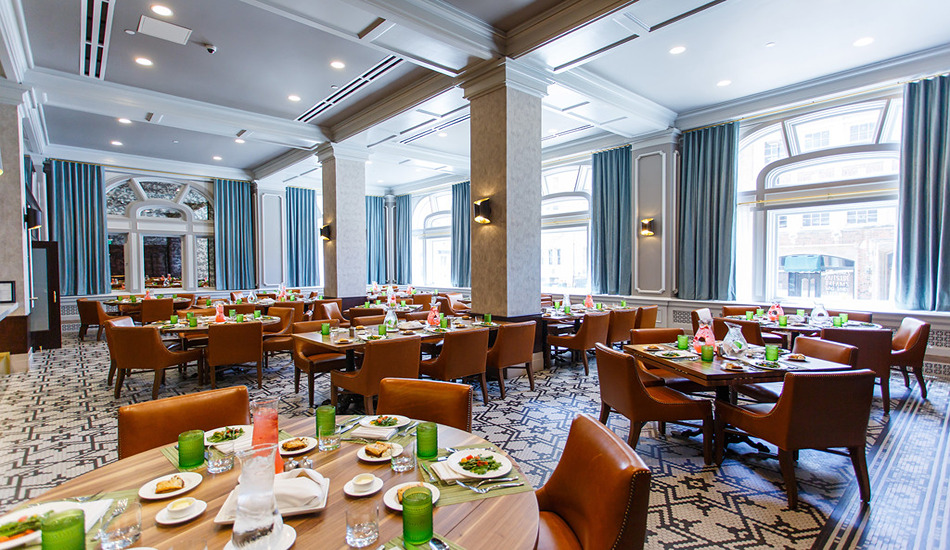
Hotel Northland’s elegant Walnut Room restaurant. (Photo credit: Hotel Northland)
Among things to know about Hotel Northland:
- The high-ceilinged, oak-paneled Walnut Room, just off the stately lobby with its matching woodwork, provides an elegant setting for dining.
- The casual Poke the Bear—its name a jab at the arch-rival Chicago Bears—is a football-themed eatery.
- The lower-level bar, The Alley, offers two bowling lanes, plus shuffleboard and billiards tables.
- Mosaic floors in public areas are original, as are the lobby and ballroom windows and many other architectural details.
- A digital sign at the front desk states: “Our clock is set to Lombardi time. If you are five minutes early, you’re already10 minutes late.” Indeed, hotel clocks, including in-room alarm clocks, are set 15 minutes ahead, a reference to one of the coach’s famous quotes.
- Another nod to Lombardi: a bronze coach’s hat on the railing of the lobby’s entrance staircase. Tapping the hat is said to bring good luck.
Other Things to Do in Green Bay
The 160-room Northland typifies the revitalization that downtown Green Bay has experienced in the last 15 or 20 years. After its indoor shopping mall floundered and finally closed in 2006, the city center became almost deserted. But today’s redeveloped downtown, clean and attractive, bustles with retail, office and residential activity. Rusted docks along the Fox River have been replaced with parkland, a major cleanup has addressed polluted waters, and a boardwalk called City Deck has become a popular spot for dining and summertime events.
The Saturday Farmers Market on South Washington and Doty streets, held 23 mornings a year, brings more than 100 vendors to downtown, as does the Wednesday afternoon/evening Farmers’ Market on Broadway. The Broadway District is noted for its restaurants, music scene and elaborate outdoor murals.
Two-hour river cruises on the cozy, 22-guest Foxy Paddler provide a peaceful way to see the city. For passengers who want to help propel the motorized paddlewheeler, 12 seats are equipped with pedals. Sights along the way include bridges, pelicans and other waterfowl, mountains of coal and gravel, and paper mills (Green Bay has been called the toilet paper capital of the world). Covered by an awning striped in orange, white and gray, the pontoon boat goes as far north as the lighthouse at South Bay Marina, where the Fox meets Green Bay, an arm of Lake Michigan.
Green Bay Car Museum Provides a Trip Down Memory Lane
The Automobile Gallery, downtown’s best attraction, shines with a collection of vintage vehicles restored to their original luster. Whereas some auto museums embellish with old-time gas pumps, mannequins in period garb and other nostalgic displays, the cars are the stars here. Or, as the museum declares, “The Automobile is the Art.” Songs from the 1950s and ’60s waft through the well-lit, pristine galleries, evoking memories from the past.
Observing that “cars and music define our lives,” the museum’s executive director, Darrel L. Burnett, says, “Everyone remembers the first car they drove.”
He adds, “If you don’t come in smiling, you’ll be smiling when you leave.”
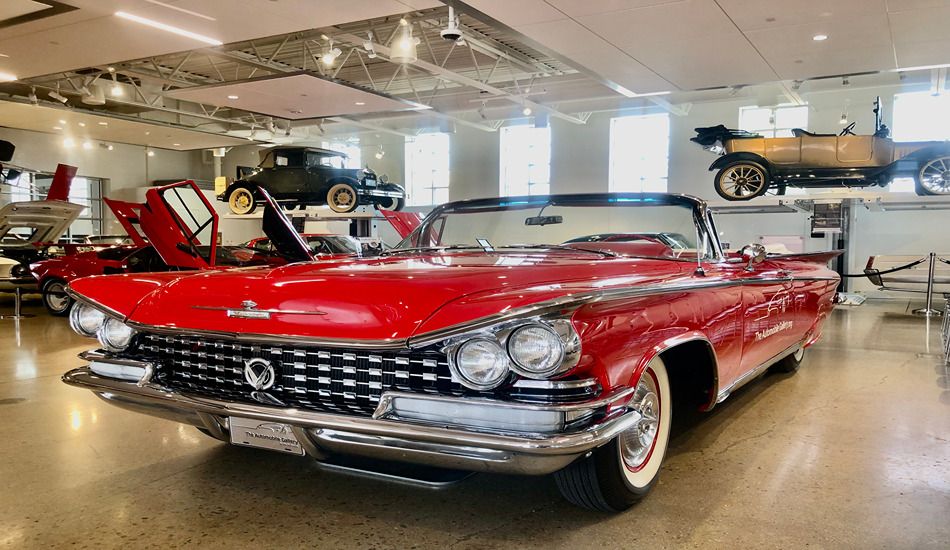
This sleek 1959 Buick LeSabre Convertible makes a dazzling centerpiece at The Auto Gallery in downtown Green Bay, Wisconsin. (Randy Mink Photo)
From a stylish 1912 Maxwell Messenger (the sports car of its day) to a 2020 race-ready Ford GT Supercar, the collection spans more than 100 years of automotive history. Favorites include:
- A rare 1917 Milburn electric car, a popular product of Milburn Wagon Factory, the largest manufacturer of farm wagons at the time
- A 1981 DeLorean DMC-12 Gull Wing Coupe, the model immortalized in the 1985 movie Back to the Future
- A 1964 Rolls Royce Silver Cloud III, one of four such limousines in the world
- An artist-decorated 1970s Volkswagen Microbus, a symbol of the hippie era
- The 1967 Corvette Sting Ray given by Sport Magazine to Packers quarterback Bart Starr for earning the Most Valuable Player Award in the first AFL-NFL Championship game (before it was called the Super Bowl).
Occupying a former Cadillac dealership, The Automobile Gallery was launched in 2016 by Green Bay native William “Red” Lewis, an innovator/entrepreneur who made his fortune in the touchless car wash business. Parts patented by Lewis, who died in 2021, are used in car washes across the country. He had collected 35 cars, and now the museum has 150, of which 106 are displayed at a given time.
Kitty-corner from the classic car corral is Captain’s Walk Winery, a comfortable place to relax over wine, hard cider and charcuterie. Complete with creaky floors and an antique oak bar, the handsome 1857 home it occupies, formerly the Green Bay Women’s Club, is the city’s third-oldest building on its original site.
Green Bay, WI offers so many things to do for families and football lovers. To get even more travel ideas and tips about Green Bay and other locations, be sure to Subscribe to Leisure Group Travel magazine for FREE
Lead Photo – The Depot restaurant, in a former train station where Green Bay Packers players once boarded and arrived, is one of many landmarks on the Packers Heritage Trail. (Randy Mink Photo)




